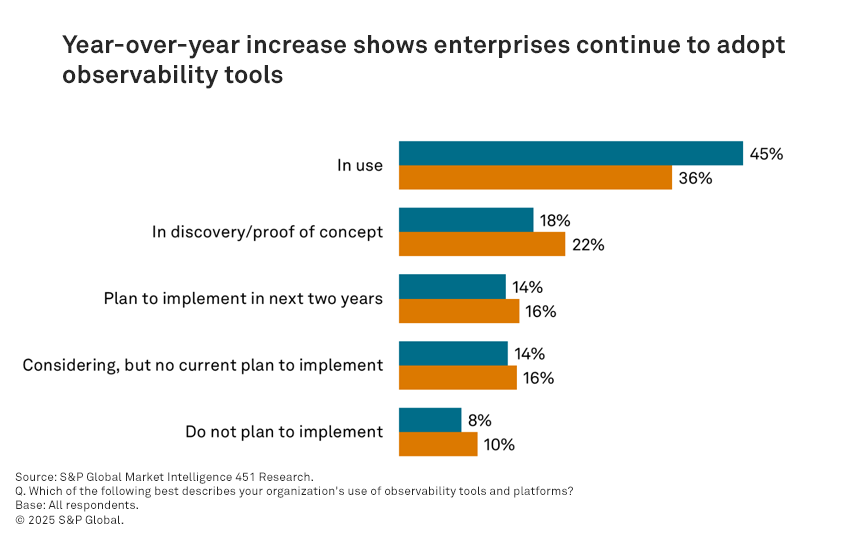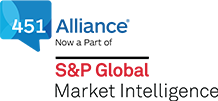
Source: Chris Griffiths/Moment/Getty images.
In a recent survey conducted by S&P Global Market Intelligence 451 Research, we revisited the theme of AI applied to observability. The survey included respondents from small to large organizations across 11 vertical markets. We saw a marked increase in the number of respondents using observability products and services from the 12 subsegments covered, and we noted clear evidence that AI is making its way into organizational workflows.
The Take
AI is everywhere, including in IT operations and observability. Early concerns about the accuracy and efficacy of AI-powered observability, including risks of incorrect analysis and recommendations and alert suppression, are up year over year. However, these concerns do not appear to be hindering adoption of AI for observability use cases, which is also up year over year. We expect to see AI use continue to grow and confidence increase as organizational buyers use the technology more and observability vendors better tune their output and customer expectations.
Summary of findings
Year over year, reported use of observability tools and platforms has risen nearly 10 percentage points to reach 45% of organizations surveyed. Our observability coverage includes 12 subsegments such as application performance monitoring, log management, network performance monitoring and observability platforms, which we define as software and services that provide holistic end-to-end and bottom-to-top analytics. Much of the increased adoption is likely among organizations that use other application and infrastructure monitoring technologies and are turning to observability to consolidate functions and to improve the quality of monitoring.

Of those that report using observability tools and platforms, 71% are using AI features and capabilities, up 26 percentage points from 2024. Another 22% are in proof-of-concept phases or plan to implement AI with observability in the next two years. The increase is due in part to advances in ML and AI capabilities embedded in observability products via features such as interactive assistants, code co-pilots, and analytic and recommendation engines.
Respondents express heightened concerns about operational aspects of AI-powered observability in 2025 compared to 2024. Nearly a third of respondents express concerns over incorrect analysis (32%, up 7 percentage points), while nearly a quarter express concerns about poor quality of recommendations (23%, up 3 points) and incorrect suppression of events or alerts (22%, up 7 points). This likely reflects growing pains with more vendors shipping AI and foundational models and with more organizations learning how to use the new tools. The percentage of respondents citing no concerns with AI remained steady in 2025 at approximately 21%.
Application performance monitoring (56%) remains the most common type of observability tool in use in 2025. Log management and analytics (45%), alerting tools (45%) and network performance monitoring (44%) round out the top four. The percentage of respondents using observability platforms is holding steady at 33%. To grow their share, observability platforms would likely need to replace or subsume some of the more popular existing monitoring tools.
This year’s survey reflects significant changes in the observability use cases where respondents believe AI will be most beneficial. More than half of respondents cite IT automation (53%, up 10 points year over year) as a major area of AI impact, suggesting growing confidence that AI can support all facets of automation, including root cause analysis, recommendations for remediation, and other workflow-related activities. A growing proportion of respondents also identify IT life-cycle management (37%, up 11 points) as an area of AI-driven benefit.
In a few observability use cases, a diminishing percentage of organizational IT respondents expect AI-powered benefits. The biggest change is in developer testing, dropping from 29% of respondents expecting positive AI impact in 2024 to 18% in 2025. Workload placement fell 6 points to 19%, and both anomaly detection (21%, down 4 points) and early warning of outages (24%, down 6 points) fell as well. The dropping confidence may be the result of factors such as the newness of applying AI to these observability use cases, and continual tuning will play a role in improving outcomes.
Want insights on cloud computing trends delivered to your inbox? Join the 451 Alliance.

